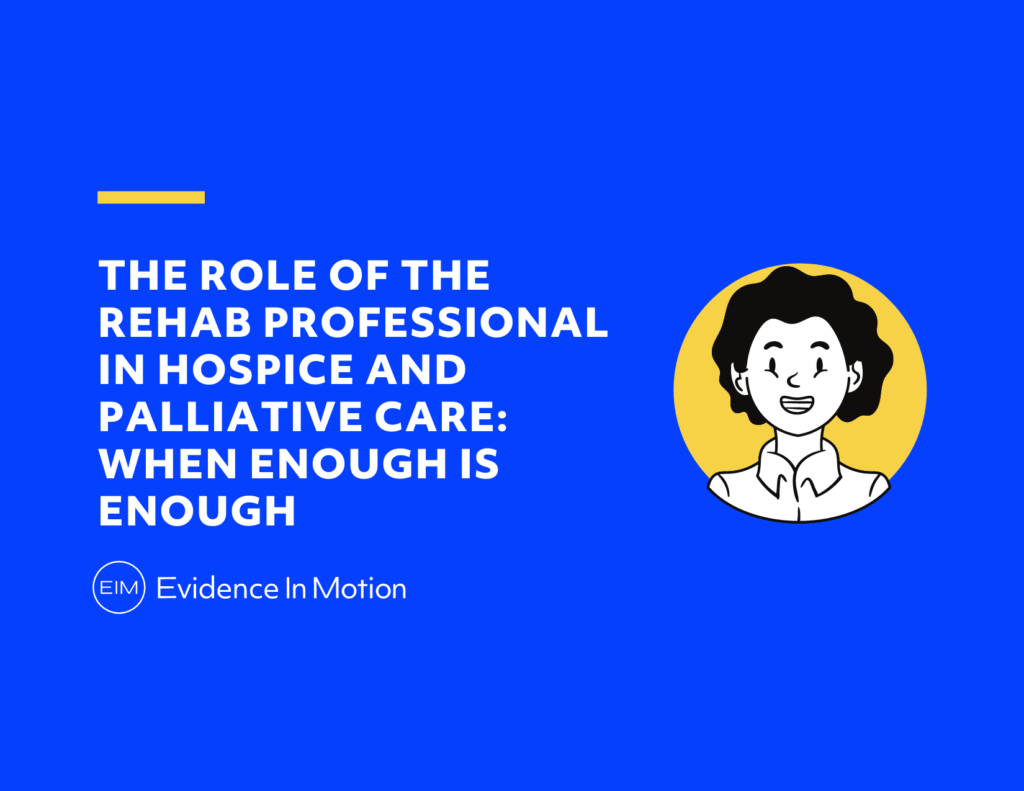
It is hard-wired in the pedagogy of rehabilitation professionals to provide evidence-informed treatment to progress and improve the lives of patients and clients. Many of us enter the health care field wanting to heal others and do good in the world. Sometimes, our interdisciplinary team’s best efforts aren’t enough to improve the lives of our patients…so then what happens?
It is difficult for many of us to accept when progress isn’t possible, and our patients are entering the final stages of their lives. Determining whether a patient is appropriate for physical and occupational therapy services occurs at more than just the evaluation; we need to be critical of which services are the right services for our patients each step of the way in their journey with us. As COVID-19 climbs to be the third leading cause of death in Americans1, hospice referrals are more and more common across disciplines and settings. This begs the question, are hospice referrals being made at the appropriate times for patients and are WE, as rehab providers, a part of that conversation?
Geriatric Certification
Interested in learning more about effectively treating the older adults you see?
Hospice is a health care right and a service just like any other. It offers physical, social, and emotional support for the patient as well as their immediate support system (family, caregivers, etc). Hospice also offers the patient control over a situation that otherwise feels uncontrollable, giving them the right to a death under the conditions that they choose, on their terms, and in the setting in which they choose to receive it.
Nearly 80% of Americans wish to die at home, but only 20% actually accomplish2 this compared to the 75% of patients on hospice who die at home as per their wishes3. While this is just one of many requests that hospice works to uphold, patients can also set other standards related to their death such as who is notified of their passing or how they wish to be cared for when they are unable to advocate for themselves near the end. Hospice also opens the door to conversations that are essential to provide optimal, patient-centered care during the end-of-life period. This facilitation of connection between the patient and their loved ones can help aid in the communication between the patient, the family, and their care providers to set clear expectations and boundaries on a topic that is often considered uncomfortable and taboo in American society.
While seen as a last resort, hospice has also been known to prolong the life of the admitted individual, if the admission is timely 4. It allows them and their support system time to prepare mentally, emotionally, and spiritually for their passing.
Advocating for our patients to receive the best care at any point in their lives, including the very end, is a core principle of what we do as rehabilitation specialists, and it is crucial for us to remember that the end matters just as much as the beginning and middle.
References
- Centers for Disease Control. Deaths and Mortality. Published April 9, 2021. Accessed January 4, 2022. https://www.cdc.gov/nchs/fastats/deaths.htm
- Where do Americans die? Published April 21, 2013. Accessed January 4, 2022. https://palliative.stanford.edu/home-hospice-home-care-of-the-dying-patient/where-do-americans-die/
- Buss MK, Rock LK, McCarthy EP. Understanding Palliative Care and Hospice: A Review for Primary Care Providers. Mayo Clin Proc. 2017;92(2):280-286.
- Bakitas MA, Tosteson TD, Li Z, et al. Early versus delayed initiation of concurrent palliative oncology care: patient outcomes in the ENABLE III randomized controlled trial. J Clin Oncol. 2015; 33(13):1438-1445.
Request More Information
